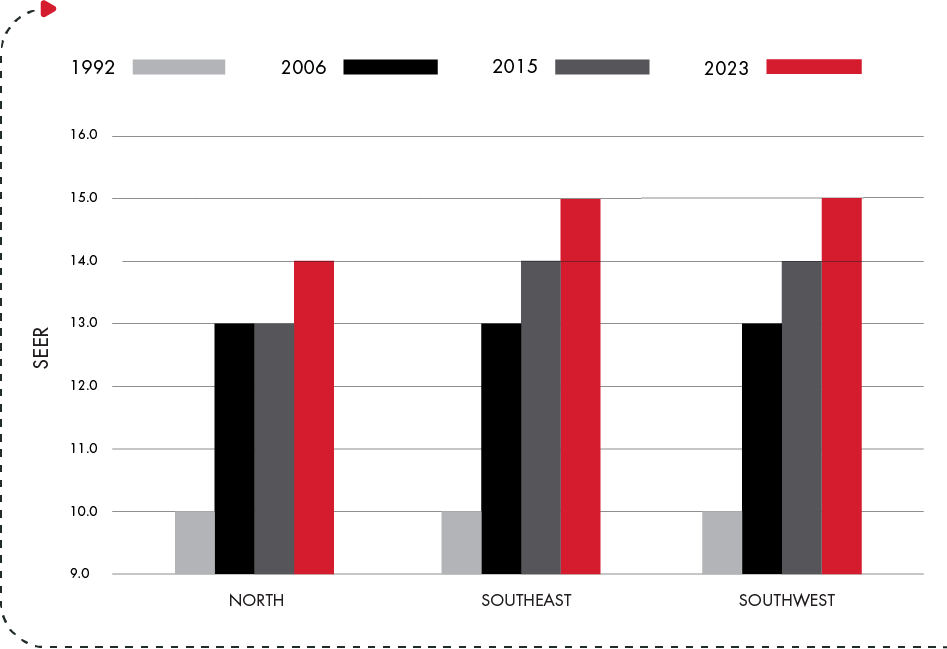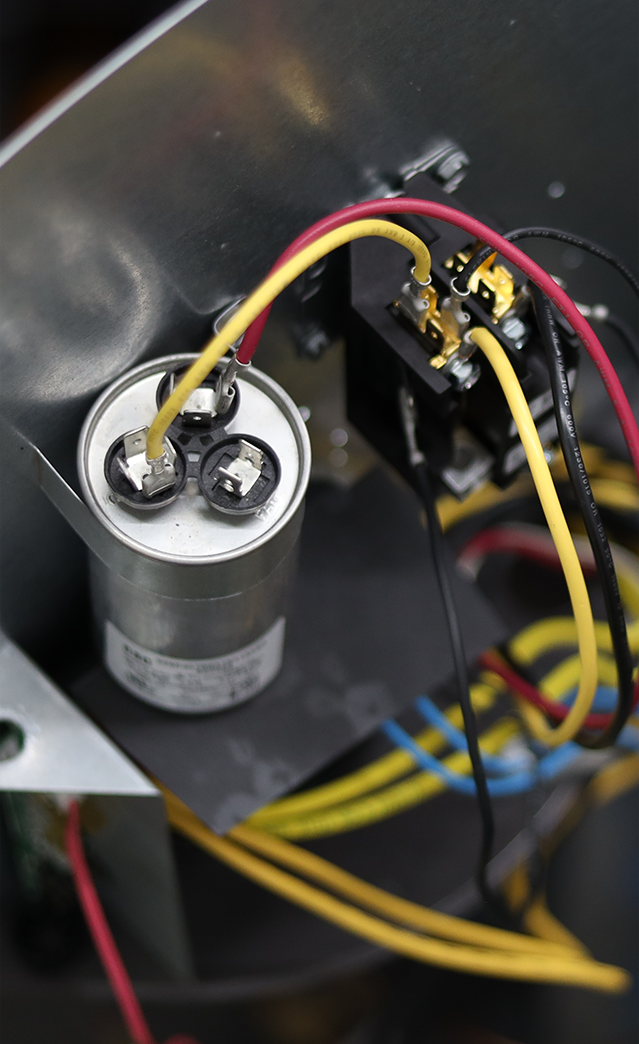Industry
Regulations
U.S. HVAC Regulations & Updates
Regulations By State
Dates and information as of 6/1/2022.
What’s New in 2023
SEER Efficiency for
Split Air Conditioners
Looking back at SEER efficiency changes for residential split air conditioners. There are new, more stringent testing procedures to determine the SEER rating of units. The new testing methods more accurately reflect field conditions. The change in testing procedures will reduce efficiency ratings versus the current SEER, EER, and HSPF ratings. As such, new metrics and nomenclature were developed. To view the information on this page as a PDF, please click here.

2023 Seer Change
REGIONS
Split air conditioners
must achieve a 14.0 SEER rating
(increased from 13.0 SEER).
SOUTHWEST
Split air conditioners
must achieve a 15.0* SEER rating
(increased from 14.0 SEER).
REGIONS
of region, must have a minimum
efficiency of 15.0 SEER
(increased from 14.0 SEER)
*15.0 SEER if <45K BTU, or 14.5 SEER if ≥ 45K BTU
EER requirements also apply in the southwest region, 12.2 EER <45K BTU or 11.7 EER ≥ 45K BTU, if SEER >16, then the EER minimum is 10.2
TESTING & MEASUREMENT REQUIRED CHANGES
2023 DOE Changes
The New Testing Will Reduce Energy Efficiency Ratings
Since testing is more stringent, the minimum DOE efficiency requirements were reduced for SEER2, EER2, and HSPF2 ratings versus the 2023 SEER, EER, and HSPF minimum requirements for each region.
Why the Reduction
in Efficiency Rating
What Else Changed
also changed.

Equipment Testing
According to the new guidelines, each tier was reoptimized and relaunched in accordance with the new DOE test procedure.
SEER2
DEPARTMENT OF ENERGY
2023 NON-COMPLIANCE

2015
Infractions
Distributors supplying non-compliant equipment to contractors.
Manufacturers knowingly selling non-compliant equipment.
Penalties May Include
and being listed on a national “no-sel” list for repeat violators.
Distributors could be barred from purchasing any of the seven classes of
products identified in the Code of Federal Regulations (10-CFR-430.32).
Manufacturers could face significant monetary fines of up to $440 per incident.
The peanalties would apply to private labelers or distributors as well.
How to Protect
Your Business
Everyone (dealers/contractors, distributors, and manufacturers) is required to track the model and serial numbers of products sold and installed, including installation locations. Keep these records for at least 60 months.
SECURING OUR FUTURE AS WELL AS OUR PARTNERS’ FUTURE
Updated all products to meet the requirements for air conditioners and heat pumps
Updated our testing procedures to the new standards
Video training
for our partners on the
DOE regulatory changes
Frequently asked Questions
Why is the DOE changing
efficiency ratings?
Every six years, the Department of Energy is required by law to review the energy use of specific home appliances and mechanical systems. Based on their review, the Department determines that an increase in energy efficiencies is cost-justified, and they set the requirements accordingly.
Are there different product sell
dates that I need to know?
Yes. Refer to the chart below.
| DOE Product Class | New Standards Effective By |
|---|---|
| Residential North / National AC | Date of Mfg. – Sell-through allowed |
| Residential Southeast AC | Date of installation |
| Residential Southwest AC | Date of installation |
| Residential National HP | Date of Mfg. – Sell-through allowed |
Why does my state have
higher requirements?
Therefore, they represent the most significant opportunity for energy savings.
How do I know if I am located in
a “regional standards state?”
| Southeast Region | Southwest Region |
|---|---|
| Alabama, Arkansas, Delaware, Florida, Georgia, Hawaii, Kentucky, Louisiana, Maryland, Mississippi, North Carolina, Oklahoma, South Carolina, Tennessee, Texas, Virginia, District of Columbia, and U.S. Territories | Arizona, California, Nevada, New Mexico |
What are the 2023 SEER,
HSPF-rated AC, and HP values?
| 2023 Values Applicable to SEER, HSPF-Rated AC and HP | ||||||
|---|---|---|---|---|---|---|
| Product | National All US States not otherwise listed as “regional standards states” | Southeast Regional Standards States Alabama, Arkansas, Delaware, Florida, Georgia, Hawaii, Kentucky, Louisiana, Maryland, Mississippi, North Carolina, Oklahoma, South Carolina, Tennessee, Texas, Virginia, District of Columbia, and U.S. Territories. | Southwest Regional Standards States Arizona, California, Nevada or New Mexico | |||
| SEER | HSPF | SEER | SEER | SEER | ||
| Split AC < 45K BTU | 14.0 | 15.0 | 45.0 | 12.2/10.2* | ||
| Split AC ≥ 45K BTU | 14.0 | 14.5 | 14.5 | 11.7/10.2* | ||
| Split HP | 15.0 | 8.8 | 15.0 | 15.0 | ||
Split Air Conditioners
2023 Regional Standards
| System Type | North Region | Southeast Region | Southwest Region | ||||||
|---|---|---|---|---|---|---|---|---|---|
| Split System ACs AC < 45K BTU) | 2015 Minimum Rating 13.0 SEER | New SEER | New SEER2 | 2015 Minimum Rating 14.0 SEER | New SEER | New SEER2 | 2015 Minimum Rating 14.0 SEER & 12.2 EER/ 11.7 EER *** | New SEER | New SEER2 |
| 14.0 SEER | 13.4 SEER2 | 15.0 SEER | 14.3 SEER2 | 15.0 SEER and 12.2 EER* | 14.3 SEER2 and 11.7 EER2** | ||||
| Split System ACs (AC ≥ 45K BTU) | 14.0 SEER | 13.4 SEER2 | 14.5 SEER | 13.8 SEER2 | 14.5 SEER and 11.7 EER* | 13.8 SEER2 and 11.2 EER2** | |||
Split System Heat Pumps
2023 NATIONAL Standards
a minimum 7.5 HSPF2. Any 14.0 SEER heat pump built before January 1, 2023, can stil be installed on or after January 1, 2023.
| System Type | National Efficiency Standard | |
|---|---|---|
| 2015 SEER and HSPF Minimum Rating | New SEER2 and HSPF2 | |
| Split System HPs | 14.0 SEER and 8.2 HSPF | 14.3 SEER2 and 7.5 HSPF2 |
Packaged Units
2023 NATIONAL Standards
| System Type | National Efficiency Standard | |
|---|---|---|
| 2015 SEER and HSPF Minimum Rating | New SEER2 and HSPF2 | |
| Packaged Units | 14.0 SEER and 8.0 HSPF | 13.4 SEER2 and 6.7 HSPF2 |





